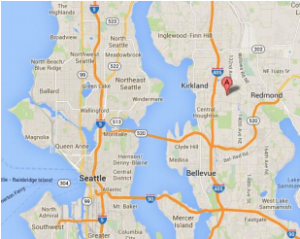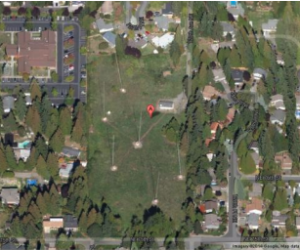Problems When the Lease Runs Out
[March 2014] Decades ago, many AM stations were built on the edge of town, or out in the boonies. Growth has often led suburbs – even pricy ones – to be built around transmitter sites.
Combined with many station transfers which left the land in the hands of someone other than the station owner, problems can happen.
It has been some time since an AM station went dark around here in Seattle, but it looks like that time has come again.
This time the victim will be KARR, 1460 kHz, a station in Kirkland. WA, Northeast of Seattle.

The six-towers for KARR’s directional antenna (DA) are located on Kirkland’s Rose-Hill, surrounded by residential uses and a church. The site is also the shared home of the night DA operation for KKDZ, Seattle, on 1250 kHz.
Just East of Kirkland is Redmond, home of Microsoft among other tech companies.
As you can well imagine, over the years, the area around the transmitter site has built up and land has become more and more valuable.

Hence, the problem: apparently neither station owns the land and the actual land owner has determined that it is time for a change. The lease for the radio stations was not renewed.
KARR, operated by Family Stations, announced that as of the end of February they will be off the air while seeking a new site. An STA from the FCC has been sought for that purpose.
KKDZ will also need to file for an STA to operate nights from their West Seattle day site, if possible, or some other site. Neither solution seems good for several reasons.
Lessons For Others
There are a number of items to consider when you think about this story. They tell a sad story about AM broadcasting in the 21st century.
The first point is, of course, not owning the dirt under your business can be risky should the land owner decides to do something different when your lease runs out. This is especially true for directional stations because even if sufficient new land is found, it may be in such a location as to cause nasty minima to appear across the station’s main service area.
The second problem is in having a multi-tower AM in a residential area like Kirkland where demand and prices have become so high. By way of contrast, this is likely why three other AM DA’s in the market are likely to be safe. Those sites, located to the South of Bellevue (near Factoria) are in a swamp area that is unlikely to see any development any time soon.
Little Choice
The question now is: can KARR ever find a suitable site and return to the air?
Only time will tell, but it does not look like an easy task. Their day pattern is fairly peanut shaped, which does not allow for a lot of NorthSouth movement to keep the signal over Kirkland.

The night pattern is even more demanding: it requires putting almost no power to the Southeast, hence that is the only viable direction to look for a new home.

With that assigned minima, the station would have to be relocated in the Southeast area of Kirkland to have enough signal to attract an audience. Sufficient land for a multi-tower array is not going to be easy to find in that area.
Another Difficult Situation
As for KKDZ, I am somewhat familiar with that facility, having worked there many years ago when it was KTW.
Back in those days, KTW did not have a nightsite and the station signed off at sunset to protect KWSU in Pullman, WA. On the other hand, today’s night DA has a main lobe is to the Southwest with severe minima to the Northwest, Southwest, and South. Just take a look at how tight they are:

It would not work out as well in the Southeast part of the area as it might for KARR, and there do not appear suitable sites to use or share in the Kirkland area.
One choice might be to operate non-directionally from their Pigeon Point transmitter day site to the Southwest of Seattle.
Nevertheless, given the protections required to other stations – especially to the East-Southeast, as shown in their night pattern above – it would likely have to be with a very low transmitter power. They would essentially become a Daytimer once again.
The Biggest Dilemma
Yet, even if one of the stations had owned the dirt, the value of the property would have likely exceeded what they could reasonably make in this day and age of diminished returns from AM station operations.
Perhaps you remember all the stations that were bought in the late 1980s and early 1990s for their land value. Many became non-directional operations at very low power levels, with many of the night arrays replaced with shopping centers and/or housing.
I understand that houses in the Kirkland site’s area are selling for north of $500k. The land owner certainly will be able to place enough houses on the land to push the decimal point over.
All-in-all, as I see it, this will continue to be a major problem across the country, with AM’s being taken dark for these and/or similar economic reasons.
– – –
Clay Freinwald is a Seattle market veteran engineer, who continues to serve clients from standalone stations to multi-station sites. You can contact Clay at K7CR@blarg.net
